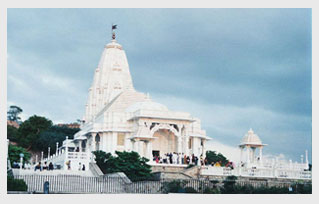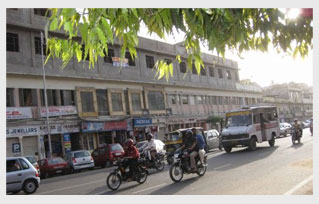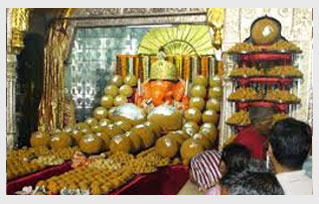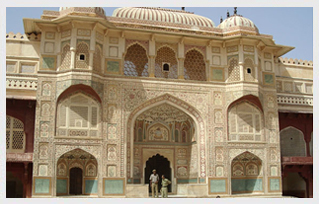
Jantar Mantar
Jaipur, India
Near the City Palace is Jantar Mantar, an observatory begun by Jai Singh in 1728, which at first glance looks like a collection of mammoth, bizarre sculptures. The guided tour (30 minutes to one hour) is well worthwhile; guides provide explanations of how each of the fascinating instruments work, and how – through watching, recording and meticulous calculation – Jai Singh measured time by the course of the sun’s shadow and charted the annual progress through the zodiac. Each construction has a specific purpose, such as calculating eclipses. The most striking instrument is the sundial, with its 27m-high gnomon; the shadow this casts moves up to 4m per hour.
The Old City
Jaipur, India
The Pink City is partially encircled by a crenellated, battle-scarred wall, and the major gates of Chandpol, Ajmer and Sanganeri have been carefully restored. The entire city is a feat of town planning; the Old City is still loosely divided into traditional artisans' quarters. Avenues divide it into neat rectangles, each one specialising in different crafts: the main bazaars are Johari Bazaar, Tripolia Bazaar, Bapu Bazaar and Chandpol Bazaar.At sunset, the buildings bask in a magical pink and gold glow.Jaipur owes its name, foundation and planning to the great warrior-astronomer Maharaja Jai Singh II (1693-1743). In 1727, with Mughal power on the wane, Jai Singh decided…
Iswari Minar Swarga Sal
Jaipur, India
A handy landmark among the chaos is Iswari Minar Swarga Sal near Tripolia Gate. The minaret was erected by Jai Singh’s son, Iswari, who later killed himself rather than face the advancing Maratha army. As the ultimate act of Rajput loyalty, 21 wives and concubines committed jauhar on his funeral pyre. You can spiral to the top of the minaret for excellent views over the old city. The entrance is around the back of the row of shops lining Chandpol Bazaar. To get there take the alley that’s 50m west of the minaret along Chandpol Bazaar, or go via the entrance to the City Palace, which is 50m west of Tripolia Gate and 200m east of the minaret.
Hawa Mahal
Jaipur, India
Jaipur’s most distinctive landmark, the Hawa Mahal is a remarkable, five-storey, delicately honeycombed, pink sandstone structure. It was constructed in 1799 by Maharaja Sawaj Pratap Singh to enable ladies of the royal household to watch the life and processions of the city. It’s an amazing example of Rajput artistry, and remains a great place for people-watching from behind the small shutters. The top offers stunning views over the Jantar Mantar and the City Palace in one direction, and over Siredeori Bazaar in the other. Inside there’s a small museum evoking the royal past.
Temple of the Sun God
Jaipur, India
The seductive Temple of the Sun God at Galta - also known as the Monkey Temple (monkeys converge here at dusk) - is 2.5km to the east of Jaipur, just beyond Surajpol Bazaar. On arrival, it's a steady 200m climb through a rocky, barren gorge, but there are spectacular views over the surrounding plains, and it's often packed with bathing pilgrims. Donations are sometimes insisted upon, and women travellers have reported feeling uncomfortable walking up here alone, particularly in the evening.
Nahargarh
Jaipur, India
Built in 1734 and extended in 1868, sturdy Nahargarh overlooks the city from a sheer ridge to the north. An 8km road runs up to the fort through the hills from Jaipur, or it can be reached along a zigzagging 2km footpath. There are some interesting furnished rooms in the fort and glorious views – it’s a popular picnic spot on weekends, and the perfect place to catch the sunset.
City Palace
Jaipur, India
This impressive palace encompasses a vast complex of courtyards, gardens and buildings. The outer wall was built by Jai Singh, but other additions are much more recent, some dating from the early 20th century. Today the palace is a blend of Rajasthani and Mughal architecture.
SRC Museum of Indology
Jaipur, India
The ramshackle, dusty treasure-trove of the SRC Museum of Indology is an extraordinary private collection of folk-art objects – there’s everything from a manuscript written by Aurangzeb to a glass bed. The museum is signposted off J Nehru Marg, south of the Central Museum.
Royal Gaitor
Jaipur, India
The site of the royal cenotaphs, just beyond the city walls, is an appropriately restful place to visit. Surrounded by a straggling village, the monuments bear much beautiful, intricate carving. The marble cenotaph of Maharaja Jai Singh II is particularly impressive.
Central Museum
Jaipur, India
This museum is housed in the recently renovated, spectacularly florid Albert Hall, south of the old city, and displays a fine array of tribalware, decorative arts, costumes, drawings and musical instruments.
Cenotaphs of the Maharanis of Jaipur
Jaipur, India
The cenotaphs of the maharanis of Jaipur are less impressive and less well maintained but OK for a stroll. They are found midway between Jaipur and Amber, opposite the Holiday Inn.


Birla Lakshmi Narayan Temple
Jaipur, India
At the foot of the small fort of Moti Dungri is the modern Birla Lakshmi Narayan Temple, with splendid marble carving. Free guides explain aspects of the temple.

Museum
Jaipur, India
Next to the Birla Lakshmi Narayan Temple there’s a small museum, which houses everyday objects from the industrially renowned Birla family.


MI Rd
Jaipur, India
MI Road is great for restaurants and for general Jaipur hubbub. Time it for sunset when the buildings turn pink.


Moti Dungri
Jaipur, India
The small fort of Moti Dungri is closed to the public


Amber Fort
Jaipur, India
The city of Amber, which was once the capital of the Kachhawaha Rajputs, traces its history over such a wide span of centuries that there are many tales and fables attached to the construction of this majestic Fort city. The colossal grandeur of Amber Fort is fascinating evidence of the grandeur of ancient times. It lies peacefully, just 11 kms away from the capital of Rajasthan, Jaipur.

 +91-0120-4779150 (10AM - 6PM)
+91-0120-4779150 (10AM - 6PM)